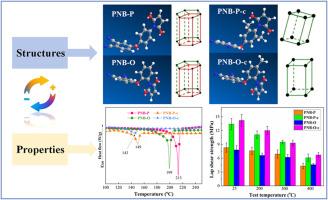Our official English website, www.x-mol.net, welcomes your
feedback! (Note: you will need to create a separate account there.)
Low-melting maleimide-containing phthalonitrile resins: Synthesis, curing behavior, and thermal performance
Polymer ( IF 4.1 ) Pub Date : 2024-11-12 , DOI: 10.1016/j.polymer.2024.127821 Caizhao Liu, Shuaijie Li, Zhigang Yuan, Shuangle Xue, Mingming Sun, Xugang Zhang, Jianhui Li, Gang Xue, Xuefeng Bai, Wenbin Liu, Bin Zhang
Polymer ( IF 4.1 ) Pub Date : 2024-11-12 , DOI: 10.1016/j.polymer.2024.127821 Caizhao Liu, Shuaijie Li, Zhigang Yuan, Shuangle Xue, Mingming Sun, Xugang Zhang, Jianhui Li, Gang Xue, Xuefeng Bai, Wenbin Liu, Bin Zhang

|
Phthalonitrile (PN) resins are highly valued in high-performance applications due to their exceptional thermal stability and mechanical properties. However, traditional PN monomers suffer from high melting points and slow curing rates, often requiring external curing accelerators that can compromise thermal performance. This study focuses on the synthesis and characterization of novel low-melting maleimide-containing PN monomers designed to enhance curing efficiency and thermal properties. Maleimide groups were introduced to improve self-catalytic properties, facilitating a more efficient curing process. The polymerization behavior, thermal stability, adhesive, and mechanical properties of these compounds were thoroughly investigated. Differential Scanning Calorimetry (DSC) and rheological tests showed that incorporating alkyl groups significantly improved flow properties, facilitating easier processing. The difference in the three-dimensional network structures of the cured PN resins was confirmed by Fourier Transform Infrared (FT-IR) spectroscopy. Thermogravimetric Analysis (TGA) demonstrated outstanding thermal stability, with 5 % weight loss temperatures ranging from 387 °C to 418 °C under air and from 420 °C to 471 °C under nitrogen. Dynamic Mechanical Analysis (DMA) confirmed high glass transition temperatures (Tg ) exceeding 400 °C, indicating superior thermal performance and making these resins suitable for advanced applications in harsh environments. These findings suggest that low-melting maleimide-containing PN systems are promising candidates for high-performance materials in aerospace, electronics, and other demanding fields.
中文翻译:

低熔点含马来酰亚胺的邻苯二甲腈树脂的合成、固化行为和热性能
邻苯二甲腈 (PN) 树脂因其卓越的热稳定性和机械性能而在高性能应用中受到高度重视。然而,传统的 PN 单体熔点高、固化速率慢,通常需要外部固化促进剂,这可能会影响热性能。本研究的重点是合成和表征新型低熔点含马来酰亚胺的 PN 单体,旨在提高固化效率和热性能。引入马来酰亚胺基团以改善自催化性能,促进更高效的固化过程。对这些化合物的聚合行为、热稳定性、粘合性和机械性能进行了深入研究。差示扫描量热法 (DSC) 和流变学测试表明,掺入烷基可显著改善流动特性,使加工更容易。固化 PN 树脂的三维网络结构的差异通过傅里叶变换红外 (FT-IR) 光谱得到证实。热重分析 (TGA) 表现出出色的热稳定性,空气中 387 °C 至 418 °C 和氮气下 420 °C 至 471 °C 的重量损失温度范围为 5%。动态机械分析 (DMA) 证实,玻璃化转变温度 (Tg) 超过 400 °C,表明这些树脂具有优异的热性能,使这些树脂适用于恶劣环境中的高级应用。这些发现表明,含低熔点马来酰亚胺的 PN 体系是航空航天、电子和其他要求苛刻的领域中高性能材料的有前途的候选者。
更新日期:2024-11-12
中文翻译:

低熔点含马来酰亚胺的邻苯二甲腈树脂的合成、固化行为和热性能
邻苯二甲腈 (PN) 树脂因其卓越的热稳定性和机械性能而在高性能应用中受到高度重视。然而,传统的 PN 单体熔点高、固化速率慢,通常需要外部固化促进剂,这可能会影响热性能。本研究的重点是合成和表征新型低熔点含马来酰亚胺的 PN 单体,旨在提高固化效率和热性能。引入马来酰亚胺基团以改善自催化性能,促进更高效的固化过程。对这些化合物的聚合行为、热稳定性、粘合性和机械性能进行了深入研究。差示扫描量热法 (DSC) 和流变学测试表明,掺入烷基可显著改善流动特性,使加工更容易。固化 PN 树脂的三维网络结构的差异通过傅里叶变换红外 (FT-IR) 光谱得到证实。热重分析 (TGA) 表现出出色的热稳定性,空气中 387 °C 至 418 °C 和氮气下 420 °C 至 471 °C 的重量损失温度范围为 5%。动态机械分析 (DMA) 证实,玻璃化转变温度 (Tg) 超过 400 °C,表明这些树脂具有优异的热性能,使这些树脂适用于恶劣环境中的高级应用。这些发现表明,含低熔点马来酰亚胺的 PN 体系是航空航天、电子和其他要求苛刻的领域中高性能材料的有前途的候选者。


















































 京公网安备 11010802027423号
京公网安备 11010802027423号